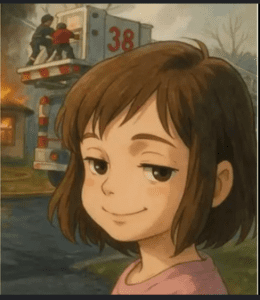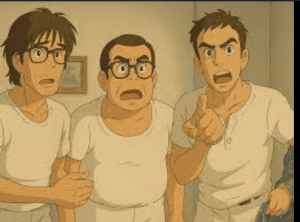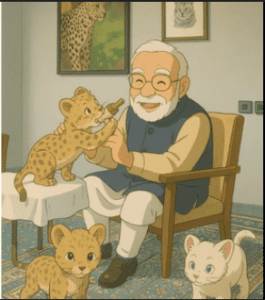California: In the ever-evolving landscape of artificial intelligence and digital creativity, a new viral sensation has taken over the internet—AI-generated Studio Ghibli-style artwork. Social media platforms are flooded with breathtaking visuals that closely mimic the hand-drawn, whimsical charm of Studio Ghibli’s most iconic films, from Spirited Away to My Neighbor Totoro. What was once an art style that required years of practice and meticulous craftsmanship is now being recreated with astonishing accuracy through AI-powered tools like DALL·E, MidJourney, and Stable Diffusion.
This explosion of AI-generated Ghibli-inspired art has sparked intense discussions about the role of artificial intelligence in creative industries. While many celebrate the accessibility and innovation AI brings to artistic expression, others question its ethical implications, particularly regarding originality, intellectual property, and the displacement of traditional animators.
 Amid this digital art revolution, OpenAI CEO Sam Altman has teased an upcoming ‘Version 2’ update, hinting at even more advanced AI capabilities that could further transform how we create and interact with digital content. Though details remain scarce, Altman’s cryptic statements have fueled speculation about whether OpenAI’s next leap will take AI-assisted creativity beyond image generation—perhaps into full-fledged animation or real-time storytelling.
Amid this digital art revolution, OpenAI CEO Sam Altman has teased an upcoming ‘Version 2’ update, hinting at even more advanced AI capabilities that could further transform how we create and interact with digital content. Though details remain scarce, Altman’s cryptic statements have fueled speculation about whether OpenAI’s next leap will take AI-assisted creativity beyond image generation—perhaps into full-fledged animation or real-time storytelling.
As the Ghibli AI frenzy collides with OpenAI’s mysterious update, we find ourselves at a crucial turning point in the relationship between artificial intelligence and artistic creation. Will AI become a tool that enhances creativity, or will it fundamentally alter how art is made and consumed? This article delves into the growing influence of AI in animation, the implications of Altman’s ‘Version 2’ tease, and the broader impact on artists, filmmakers, and the digital world.
The Rise of AI-Generated Ghibli Art: A Viral Sensation
Studio Ghibli, the world-renowned Japanese animation studio behind masterpieces like Spirited Away, My Neighbor Totoro, and Princess Mononoke, has captivated audiences for decades with its handcrafted animation, intricate landscapes, and emotionally rich storytelling. However, the rise of AI-powered image-generation tools has led to an unprecedented surge in Ghibli-style AI-generated artwork, sparking both fascination and debate.
AI-generated art has existed for years, but recent advancements in deep learning, neural networks, and text-to-image models have brought AI-generated Ghibli-inspired visuals to life with stunning accuracy. The ability to replicate the soft pastel color palettes, ethereal lighting, and whimsical fantasy worlds associated with Studio Ghibli has captured the imagination of millions online.
Why is AI-Generated Ghibli Art Trending?
Several factors have contributed to the viral explosion of AI-generated Ghibli-style artwork:
1. Aesthetic Appeal
This newfound capability has sparked widespread excitement among animation enthusiasts, artists, and casual users alike. The AI-generated Ghibli-style art retains the signature soft color palettes, intricate lighting effects, and whimsical compositions that define Studio Ghibli’s magic. From sun-drenched fields to moonlit villages, these AI-rendered artworks evoke the same sense of wonder and nostalgia that fans associate with classics like Howl’s Moving Castle and The Wind Rises.
Additionally, AI tools now offer customization options, enabling users to tweak details such as character expressions, weather conditions, and atmospheric depth—elements that were previously the exclusive domain of skilled animators. This technological leap raises fascinating questions about the role of AI in artistic creativity and whether machine-generated art can ever truly match the human touch of masterful animators like Hayao Miyazaki.
2. AI Accessibility
Previously, creating Ghibli-style artwork required years of experience in traditional and digital painting. Today, AI democratizes this process, enabling anyone—regardless of artistic skill—to produce stunning Ghibli-like visuals by simply typing a prompt.
🔹 Example: Users can enter prompts like:
“A cozy Japanese village at sunset, in the style of Studio Ghibli”
…and within seconds, AI tools generate breathtaking hand-drawn-looking illustrations.
3. Viral Social Media Trends


How AI-Ghibli Art is Dominating Social Media
✔ Twitter (X):
-
The hashtag #AIGhibli is trending, with thousands of users experimenting with AI prompts to generate their own Ghibli-style landscapes and character art.
-
Influencers and AI artists are hosting prompt challenges, encouraging users to fine-tune AI models for more authentic Ghibli-style visuals.
-
Animated AI clips mimicking scenes from Ghibli classics like Spirited Away and Howl’s Moving Castle are gaining millions of views.
✔ Instagram & Pinterest:
-
AI-generated fantasy landscapes, sky castles, and mystical creatures inspired by Hayao Miyazaki’s worlds are receiving millions of likes and shares.
-
AI-powered animation loops resembling Ghibli’s iconic moving skies and surreal dream sequences are trending in reels.
-
Aesthetic AI-generated wallpapers and Ghibli-inspired AI character portraits have become viral design trends.
✔ Reddit & Discord:
-
AI art communities on r/AIArt and r/studioghibli are dedicated to perfecting AI prompts to produce high-quality, human-like Ghibli artwork.
-
Discord servers are hosting live AI art battles, where members generate and vote on the best AI-created Ghibli-style images.
-
Artists and developers discuss ways to ethically train AI models to replicate Ghibli aesthetics while respecting original artistry.
✔ TikTok & YouTube Shorts:
-
Before-and-after AI transformation videos (turning real-life photos into Ghibli-style visuals) are viral on TikTok.
-
AI speed-painting videos showing the process of generating breathtaking AI Ghibli-style backgrounds in real-time are gaining millions of views.
-
YouTubers are reviewing the best AI tools for Ghibli art and testing different AI models like DALL·E 3, Stable Diffusion, and MidJourney to create the most authentic Miyazaki-inspired images.
4. Evolving AI Creativity
AI is no longer just an automated tool—it is emerging as a co-creator in the artistic process.
-
AI-generated Ghibli-style concept art is being used for indie games, animated shorts, and book illustrations.
-
Artists are experimenting with AI-assisted backgrounds to speed up animation production.
-
AI art challenges blur the lines between human creativity and machine-generated visuals.
As Ghibli AI artwork dominates online spaces, one pressing question arises—how will AI evolve in the future of artistic creation?
Sam Altman Hints at OpenAI’s Next Big Leap: Version 2
While the Ghibli AI wave sweeps the internet, Sam Altman, CEO of OpenAI, has teased a major update—‘Version 2’—that could redefine AI-generated creativity. Although specific details remain undisclosed, speculation about OpenAI’s next breakthrough is already running wild.
What Could OpenAI Version 2 Bring?
The next iteration of OpenAI’s creative AI technology could push the boundaries of animation, image consistency, and real-time rendering.
🔹 1. Advanced AI Creativity: The Future of AI-Generated Animation
Right now, AI can generate single static Ghibli-style images, but what if it could animate them into full-fledged short films?
✅ AI-Driven Animation Tools:
-
OpenAI Version 2 might introduce AI-powered animation capabilities, where users can generate animated scenes rather than just still images.
-
This could revolutionize indie animation studios and digital artists, who could create short films without traditional frame-by-frame animation.
✅ AI-Assisted Storyboarding:
-
Future AI could take a script or story concept and automatically generate storyboards in a Ghibli-like style.
-
This could help directors, concept artists, and animators visualize ideas instantly.
📌 Potential Impact:
This could democratize animation production, allowing smaller creators to bring their ideas to life without a massive studio budget.
🔹 2. Improved Image Consistency: Solving AI Art’s Biggest Flaw
One major limitation of current AI-generated art is the lack of character consistency across multiple images. If you generate a Ghibli-style character, then try to recreate them in another image, the AI often fails to match features precisely.
✅ How Version 2 Could Fix This:
-
OpenAI’s update might introduce “Character Memory”, allowing AI to retain key visual details so the same character can appear consistently across multiple frames.
-
This improvement could pave the way for AI-generated webcomics, animated sequences, and illustrated books.
📌 Potential Impact:
If AI can generate entire animated sequences with consistent characters, it could accelerate digital storytelling, making AI a more useful tool for animation studios and creators.
🔹 3. Faster and More Realistic Rendering: AI-Powered Film Production
If AI can already generate high-quality static images in seconds, what if it could render frame-by-frame AI animation in real-time?
✅ Future AI Tools Could Offer:
-
AI-powered video rendering, reducing the need for traditional CGI post-production.
-
Faster animation workflows, cutting production time by 70-80%.
-
Automated background and scene transitions for seamless Ghibli-style storytelling.
📌 Potential Impact:
AI-assisted rendering could revolutionize film production, making animated movies and shorts far more cost-effective and time-efficient.
🔹 4. Text-to-Video Evolution: Expanding AI Filmmaking
OpenAI’s Sora model has already demonstrated the ability to generate short AI-powered video clips. What if OpenAI Version 2 expanded this into full-length AI-generated animation?
✅ How This Could Work:
-
Users could input a script, and AI would generate a fully animated short film in a Ghibli-like style.
-
AI could add camera movements, scene transitions, and sound effects automatically.
-
AI tools might allow real-time animation editing, where creators could tweak characters, expressions, and movements instantly.
📌 Potential Impact:
This would be a game-changer for independent filmmakers, allowing them to create entire animated films with minimal resources.
The Impact of AI on Animation and the Creative Industry
As artificial intelligence continues to evolve, its integration into the animation and creative industries is reshaping the way art is produced, consumed, and distributed. The rise of AI-generated Ghibli-style art has ignited both excitement and concern within the creative community. While AI tools can democratize artistic creation, enhance efficiency, and unlock new storytelling possibilities, they also raise significant ethical, legal, and philosophical questions about the future of animation.
Why AI in Animation is Revolutionary
AI-driven tools have already started to transform the animation industry, offering groundbreaking advantages that were once unimaginable.
✔ Faster Production Time
Traditionally, hand-drawn animation is an incredibly time-consuming process, requiring artists to craft thousands of frames to create fluid motion. AI, however, can generate detailed backgrounds, character designs, and entire sequences in minutes. This significantly speeds up production for studios, allowing them to produce more content in a shorter timeframe.
🔹 Example: AI-assisted software like Runway ML, DeepMotion, and NVIDIA’s GAN-based animation tools are capable of generating motion sequences, reducing the workload of animators.
✔ Accessibility to Artists
For independent animators and small studios, high-quality animation was once out of reach due to budget and manpower constraints. AI-powered tools can now provide affordable and efficient alternatives, allowing smaller creators to produce Ghibli-style or even Pixar-level animations without a massive production team.
🔹 Example: AI-based platforms like DALL·E, Stable Diffusion, and MidJourney are already being used to generate animation frames, backgrounds, and character sketches with remarkable detail.
✔ Innovation in Storytelling
AI is not just replicating traditional animation techniques—it is expanding the possibilities of storytelling. By generating unique visual styles, suggesting creative scene compositions, and even helping with scriptwriting, AI is allowing artists to explore new narrative dimensions that were previously limited by time and resources.
🔹 Example: AI-driven storyboard generators and AI-powered scriptwriting assistants can help artists and writers refine their creative vision without needing large teams.
Potential Drawbacks of AI in Artistic Creation
Despite its advantages, the rise of AI in animation has also sparked significant debates about ethics, employment, and artistic authenticity.
❌ Ethical Concerns: Copyright and Intellectual Property Issues
One of the biggest controversies surrounding AI-generated art is its reliance on pre-existing artwork. AI models are trained on vast datasets of existing paintings, animations, and illustrations—often without explicit consent from the original creators. This raises serious questions about intellectual property rights and fair use.
🔹 Legal Challenge: Some artists argue that AI-generated content infringes upon their work, as AI tools can mimic styles without proper attribution or compensation. This has led to lawsuits against AI developers who use unlicensed art in their training data.
❌ Job Displacement in the Animation Industry
The automation of animation tasks means that certain entry-level jobs in studios—such as in-between animators, background artists, and storyboard designers—may be at risk. If AI can generate full animation sequences with minimal human input, what will happen to the thousands of traditional animators worldwide?
🔹 Case Study: Some major studios are already experimenting with AI animation tools to cut costs, raising fears that traditional animators may be replaced in favor of cheaper AI-driven alternatives.
❌ Lack of Human Emotion and Artistic Depth
While AI is becoming highly skilled at mimicking art styles, it still struggles with emotional depth, fluidity, and nuance. Studio Ghibli’s magic lies not just in its artistic beauty, but in the emotional storytelling, character expression, and subtle animation choices—something AI has yet to fully replicate.
🔹 Example: AI-generated character animations may look visually stunning, but they often lack the soulful human touch that makes hand-drawn animation so impactful.
The Future of AI-Generated Art and Animation
With the rise of AI-generated Ghibli-style art and OpenAI CEO Sam Altman teasing a ‘Version 2’ update, we are on the brink of a major transformation in the way animation is created. But what does the future hold?
🔹 AI-Driven Filmmaking
Future AI tools could generate entire animated short films or even feature-length movies with minimal human intervention. AI-powered directing, scene composition, and voice synthesis could enable fully automated animation production.
While AI filmmaking promises efficiency, accessibility, and creative expansion, it also raises concerns about job displacement for traditional animators, ethical copyright issues, and the potential loss of human artistic intuition in storytelling. However, industry experts believe that AI will act as a collaborative tool rather than a full replacement, empowering creators to bring their visions to life more efficiently.
As AI technology advances, the boundaries of what’s possible in animation and filmmaking continue to expand, offering exciting possibilities for independent creators, large studios, and audiences eager for new, AI-enhanced cinematic experiences.
🔹 Possibility: Studios may soon be able to create low-budget yet visually stunning AI-animated films, revolutionizing the independent filmmaking scene.
🔹 Real-Time AI Illustration
Artists may soon be able to sketch rough ideas and have AI refine them in real-time, allowing for instant enhancement of drawings, colorization, and even animation. This could become a powerful collaborative tool rather than a full replacement for human artists.
🔹 Example: Software like Clip Studio Paint’s AI-powered drawing tools is already moving in this direction.
🔹 Interactive AI Storytelling
AI-powered engines could allow users to generate their own interactive animations in real-time, letting them create customized Ghibli-like experiences on demand. This could lead to AI-generated video games, animated storytelling apps, and immersive VR experiences.
🔹 Future Vision: Imagine a world where you could input a story idea into AI, and within minutes, it creates a fully animated scene tailored to your vision.
Conclusion: A New Era of AI-Driven Creativity and Storytelling


The benefits of AI-powered creativity are undeniable—faster production times, accessibility for aspiring artists, and groundbreaking innovations in visual storytelling. With the rapid advancements in AI, we may soon see tools that allow creators to generate entire animated sequences, interactive AI-assisted illustrations, or even real-time AI filmmaking.
However, this new frontier also presents critical challenges. Questions surrounding copyright, artistic authenticity, and the displacement of traditional animators remain largely unanswered. If AI can replicate and even improve upon established art styles, how do we ensure that human creativity remains at the heart of storytelling?
Sam Altman’s ‘Version 2’ tease suggests that OpenAI is preparing to push the boundaries of AI-assisted art even further. Whether this next evolution leads to more powerful AI-generated animation tools or entirely new forms of interactive digital storytelling, one thing is certain—AI is no longer just an assistant in creativity; it is becoming a collaborator.
As we move forward, the challenge will be to balance innovation with ethical responsibility, ensuring that AI empowers artists rather than replaces them. The world eagerly awaits OpenAI’s next move, but one thing is clear—the fusion of AI and art is no longer the future; it is the present.
Stay tuned for further updates on AI’s impact on digital creativity and storytelling by following OpenAI’s official website. 🚀
For more real time updates, visit Channel 6 Network.

